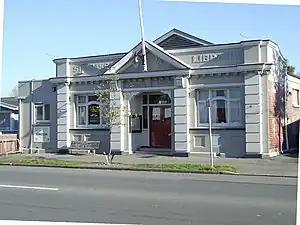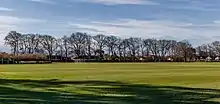St Albans, New Zealand
St Albans is a large, inner-northern suburb of Christchurch, New Zealand, located directly north of the Christchurch Central Business District. It is the second largest suburb in the city by population (behind Halswell), with a population of 13,137 at the 2018 Census. The suburb falls within the Christchurch Central electorate and is represented by Duncan Webb, who has been the member of parliament since the 2017 general election. St Albans is one of the most diverse residential neighbourhoods in Christchurch, with a wide range of densities, architectural styles and housing ages throughout the suburb. It has everything from run-down high-density council-owned flats, to modern luxurious high-density flats and apartments; old mid-density workers cottages through to large low-density estates of various ages.
St Albans | |
|---|---|
 The old St Albans library, since demolished following earthquake damage | |
| Coordinates: 43.508°S 172.630°E | |
| Country | New Zealand |
| City | Christchurch |
| Local authority | Christchurch City Council |
| Electoral ward |
|
| Community board |
|
| Area | |
| • Land | 397 ha (981 acres) |
| Population (June 2023)[2] | |
| • Total | 13,830 |
| Postcode(s) | 8014 |
| Papanui | Northcote | Mairehau |
| Strowan Merivale |
|
Edgeware |
| Christchurch Central City |
History
Originally a working-class settlement, St Albans was a separate borough from 1881 until 1903 when it became part of Christchurch City. St Albans was named after George Dickinson's farm, which lay to the south of the St Albans Creek. He had called his farm St Albans in memory of his cousin Harriet Mellon, an actress, who had become the Duchess of St Albans.[3]
Earthquake damage
The suburb escaped severe damage in the 2010 Canterbury earthquake. Many chimneys came down but only a few complete houses were affected. In the 22 February 2011 earthquake, however, the suburb was hit hard. Many houses, supermarkets, and shops were significantly damaged with a lot ending up totally demolished. In July 2011, the demolition of the former library, which houses the community centre, was ordered by the Canterbury Earthquake Recovery Authority.[4] By 2014 the extent of the damage to drainage systems and lowered ground levels had become apparent, with the regular flooding of a series of streets known as the Flockton Basin.[5]
Boundaries
The suburb of St Albans is bordered by:
- Merivale to the west (West of Papanui Road – South of Innes Road)
- Strowan to the north-west (West of Papanui Road – North of Innes Road)
- Papanui to the north (North of Tomes Road)
- Mairehau to the north-east (East of Jamieson Avenue, Severn Street and Forfar Street – North of Warrington Street)
- Edgeware to the east (East of Forfar Street – South of Warrington Street and East of Madras Street – North of Bealey Avenue)
- Christchurch Central City to the south (South of Bealey Avenue).
These correspond roughly to the NZ Localities area maintained by Fire and Emergency NZ.[6]
Inconsistencies
The borders of St Albans are often disputed, particularly by real estate agents who often list higher-priced properties that lie within western St Albans as belonging to Merivale instead. The original borough of St Albans stretched to include most of modern-day Edgeware, Mairehau and Merivale as well as the current St Albans suburb. There is a sign off of Bealey Avenue which points to St Albans down Barbadoes Street which is actually in the middle of the suburb of Edgeware instead of St Albans.
Demographics
St Albans covers 3.97 km2 (1.53 sq mi).[1] It had an estimated population of 13,830 as of June 2023, with a population density of 3,484 people per km2.
| Year | Pop. | ±% p.a. |
|---|---|---|
| 2006 | 12,987 | — |
| 2013 | 12,768 | −0.24% |
| 2018 | 13,137 | +0.57% |
| Source: [7] | ||
St Albans had a population of 13,137 at the 2018 New Zealand census, an increase of 369 people (2.9%) since the 2013 census, and an increase of 150 people (1.2%) since the 2006 census. There were 5,448 households, comprising 6,498 males and 6,633 females, giving a sex ratio of 0.98 males per female, with 2,043 people (15.6%) aged under 15 years, 3,231 (24.6%) aged 15 to 29, 6,087 (46.3%) aged 30 to 64, and 1,773 (13.5%) aged 65 or older.
Ethnicities were 82.9% European/Pākehā, 7.0% Māori, 2.0% Pasifika, 12.8% Asian, and 2.9% other ethnicities. People may identify with more than one ethnicity.
The percentage of people born overseas was 28.0, compared with 27.1% nationally.
Although some people chose not to answer the census's question about religious affiliation, 50.6% had no religion, 36.7% were Christian, 0.2% had Māori religious beliefs, 2.2% were Hindu, 0.8% were Muslim, 1.2% were Buddhist and 3.6% had other religions.
Of those at least 15 years old, 3,894 (35.1%) people had a bachelor's or higher degree, and 1,098 (9.9%) people had no formal qualifications. 2,622 people (23.6%) earned over $70,000 compared to 17.2% nationally. The employment status of those at least 15 was that 6,387 (57.6%) people were employed full-time, 1,638 (14.8%) were part-time, and 324 (2.9%) were unemployed.[7]
| Name | Area (km2) | Population | Density (per km2) | Households | Median age | Median income |
|---|---|---|---|---|---|---|
| Malvern | 0.99 | 2,604 | 2,630 | 918 | 34.6 years | $44,500[8] |
| Rutland | 0.99 | 2,904 | 2,933 | 1,071 | 43.8 years | $43,100[9] |
| St Albans North | 0.64 | 2,136 | 3,338 | 966 | 37.1 years | $37,000[10] |
| St Albans West | 0.68 | 2,523 | 3,710 | 1,182 | 37.5 years | $39,500[11] |
| St Albans East | 0.68 | 2,970 | 4,368 | 1,311 | 32.8 years | $39,700[12] |
| New Zealand | 37.4 years | $31,800 |
Community facilities

The hub of St Albans is Edgeware Village on Edgeware Road which contains a small number of well-supported shops. The three main parks in the suburb are St Albans Park,[13] Abberley Park, and Malvern Park.[14] Sports facilities include Canterbury United Football Club's stadium, English Park, and Rugby Park, the home of the Crusaders professional rugby union team.
Education
The suburb contains two primary schools, St Albans Primary School[15] and St Albans Catholic School,[16] which both provide education for years 1 to 6.[17][18] As of April 2023, they have rolls of 499 and 111 students, respectively.[19] St Albans School opened in 1873[20] and St Albans Catholic School opened in 1955.[21]
St Albans News
St Albans is known for its sense of cohesiveness and community spirit. This has manifested itself in the local monthly paper, the St Albans Neighbourhood News,[22] which was first published by a group of local residents in 1993 and is still going to this day under the name of St Albans News. Distributed to 5,000 homes and businesses, the paper has recently been expanded to fill 16 pages. Over the years it has been central in numerous community-related issues including local planning, Packe Street Park, the Edgeware Road Tragedy, and the closure of Edgeware swimming pool (to which it was editorially opposed). After the community regained control of the pool site, it was announced that the pool would be rebuilt with a generous donation from a local resident.[23]
Notable residents
- Hugh Acland (1874–1956), prominent surgeon and later owner of Chippenham[24]
- John Evans Brown (1827–1895), first MP for St Albans, after whom Browns Rd is named, and resident at Chippenham[25]
- Richard Hadlee (born 1951), international cricketer
- Violet Targuse (1884–1937), playwright, lived on Bretts Road at time of death
- The Wizard of New Zealand (born 1932), lived in the suburb until his Cranford Street home was destroyed by fire in September 2003
- Tane Norton (1942–2023), All Black, local resident and businessowner
References
- "ArcGIS Web Application". statsnz.maps.arcgis.com. Retrieved 20 September 2021.
- "Population estimate tables - NZ.Stat". Statistics New Zealand. Retrieved 25 October 2023.
- St Albans, from Swamp to Suburbs, An Informal History. New Zealand federation of University Women Canterbury Branch. 1989. pp. 13–14. ISBN 0-473-00693-6.
- "Deconstruction of damaged Council-owned community facility". Christchurch City Council. Retrieved 23 July 2011.
- Cairns, Lois (6 March 2014). "Flockton flood protection two years away". The Press. Retrieved 1 December 2015.
- "NZ Suburbs and Localities". Toitū Te Whenua - Land Information New Zealand. Retrieved 18 September 2023.
- "Statistical area 1 dataset for 2018 Census". Statistics New Zealand. March 2020. Malvern (322100), Rutland (322200), St Albans North (323800), St Albans West (323900) and St Albans East (324800).
- 2018 Census place summary: Malvern
- 2018 Census place summary: Rutland
- 2018 Census place summary: St Albans North
- 2018 Census place summary: St Albans West
- 2018 Census place summary: St Albans East
- "A to Z of Christchurch Parks – St Albans Park". .ccc.govt.nz. Retrieved 16 February 2014.
- "A to Z of Christchurch Parks – Malvern Park". .ccc.govt.nz. Retrieved 16 February 2014.
- "St Albans School | Welcome to our website". St Albans School. 4 July 2013. Retrieved 16 February 2014.
- "St Albans Catholic School (Christchurch) .::. Welcome". St Albans Catholic School. Retrieved 16 February 2014.
- Education Counts: St Albans School
- Education Counts: St Albans Catholic School
- "New Zealand Schools Directory". New Zealand Ministry of Education. Retrieved 12 December 2022.
- Centennial, 1873–1973 St Albans School. Christchurch City Libraries. 1973. Retrieved 20 September 2021.
- "School History". St Albans Catholic School. Retrieved 20 September 2021.
- "The St Albans Community Website". Retrieved 18 September 2023.
- Conway, Glenn (26 March 2010). "Edgeware community wins pool fight". The Press. Retrieved 13 November 2011.
- Maling, Peter B. "Acland, Hugh Thomas Dyke". Dictionary of New Zealand Biography. Ministry for Culture and Heritage. Retrieved 7 January 2012.
- "Chippenham Lodge". New Zealand Heritage List/Rārangi Kōrero. Heritage New Zealand. Retrieved 16 February 2014.